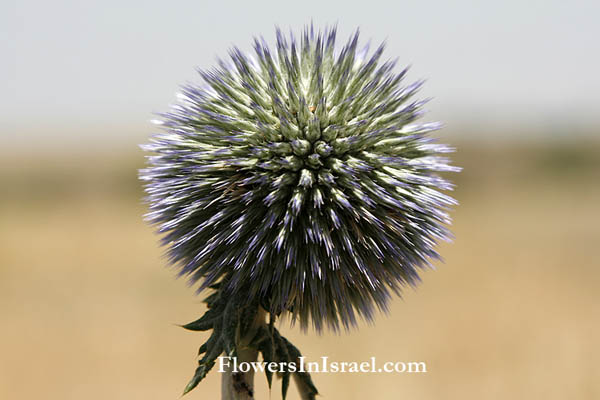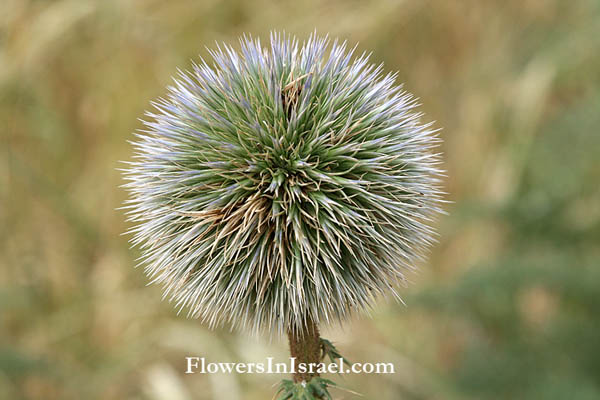قَرْقَفان غَيَّرْدوه ,קיפודן גיירדו
| Scientific name: | Echinops gaillardotii Boiss. | |
| Common name: | Gaillardot’s globe-thistle | |
| Hebrew name: | קיפודן גיירדו | |
| Arabic name: | قَرْقَفان غَيَّرْدوه | |
| Family: | Compositae / Asteraceae, מורכבים |

|
| Life form: | Hemicryptophyte | |
| Spinescence: | Leaves, bracts | |
| Stems: | Stem bases not surrounded by remains of old leaves; 100-170 cm tall, few branched, covered with purple (glandular or eglandular) bristles, or white arachnoid to lanate with purple bristles | |
| Leaves: | Alternate, rosette, lanceolate, dissected twice or more, spinescent; arachnoid or with scabrous and glandular hair above, soft white lanate below. Leaf bases with triangular spiny-lobes, 1/2-2/3 palmate at apex. Uppermost leaves sessile, semi-amplexicaule with lanceolate lobes spiny at ends. Leaf axis usually winged. | |
| Flowers: | Heads 4-6 cm diam., capitula 25-30 mm long, bluish-violet; involucral bracts 19-21, glabrous or woolly; middle bracts 22-30 mm long; inner bracts 20-25 mm long, connate in basal 1/2 or more and accrete in to a membranous cylindrical tube; brush dirty white or straw coloured, 14-18 mm, usually 1/2 as long as involucre; corolla bluish-violet. | |
| Fruits / pods: | Achene elliptic, 12-13 mm; pappus connate at base | |
| Flowering Period: | June, July | |
| Habitat: | Batha, Phrygana | |
| Distribution: | Mediterranean Woodlands and Shrublands, Semi-steppe shrublands, Montane vegetation of Mt. Hermon | |
| Chorotype: | Mediterranean | |
| Summer shedding: | Perennating |

Derivation of the botanical name: Echinops, echinos, εχινοϛ, sea-urchin, hedgehog; opsis, like; in allusion to this herb's spiny, globe-shaped flower heads of metallic blue. gaillardotii , named after Charles Gaillardot (1814 - 1883), a French surgeon and botanist in Egypt and Syria (Lebanon). The Hebrew name: קפודן, קיפודן, kipodan, "a hedgehog", for the flowers are arranged in a spherical inflorescence similar to a hedgehog (kipodan).
|